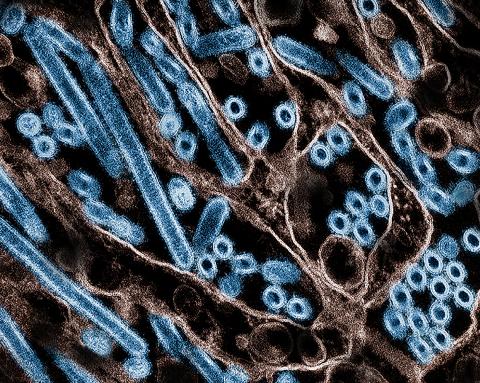Bovine H5N1 Influenza from Infected Worker Transmissible and Lethal in Animal Models

Photo: NIAID/CDC
A highly pathogenic avian influenza (HPAI) H5N1 virus, isolated from the eye of a farm worker who became infected through contact with dairy cows, was lethal in mice and ferrets according to a new study in Nature. The study investigators also found that the virus isolated from the worker, who experienced mild inflammation of the cornea (conjunctivitis), could be transmitted through the air between separated ferrets and might be capable of binding to and replicating in human respiratory tract cells.
The virus isolated from the worker is called huTX37-H5N1 and has a mutation (PB2-E627K) frequently seen in avian influenza viruses that replicate in mammals, typically making virus replication more efficient. These mutations underscore the need for continued monitoring and evaluation of viruses from the current H5N1 outbreak.
Investigators found huTX37-H5N1 replicated in human cornea and lung cells and also infected each of 15 different mouse tissues tested, with the highest virus levels found in respiratory tissues.
Researchers infected ferrets with a high dose of huTX37-H5N1. Flu infections in ferrets more closely resemble human flu infections than those in mice. All infected ferrets died within 5 days and scientists found huTX37-H5N1 virus in all the tissues sampled, with high levels in the respiratory system.
To evaluate respiratory transmission, the scientists placed healthy ferrets in cages next to ferrets infected one day earlier with one of four decreasing doses of huTX37-H5N1. All directly infected ferrets died within 6 days and between 17% and 33% of the nearby animals became infected via respiratory droplet transmission.
The person infected with the huTX37-H5N1 virus did not develop severe illness. In fact, human cases reported from the current outbreak have mostly experienced conjunctivitis and/or mild respiratory symptoms. Multiple exposures to seasonal human influenza viruses, they say, might provide people with low levels of protection against currently circulating HPAI H5N1 viruses—though additional study is needed.
